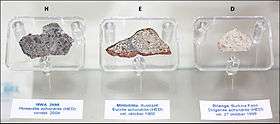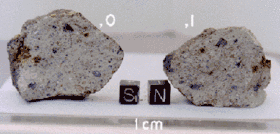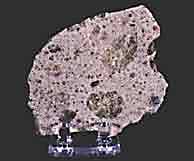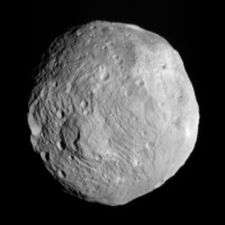HED meteorite
HED meteorites are a clan (subgroup) of achondrite meteorites. HED stands for "howardite–eucrite–diogenite". These achondrites came from a differentiated parent body and experienced extensive igneous processing not much different from the magmatic rocks found on Earth and for this reason they closely resemble terrestrial igneous rocks.[1]
| HED meteorite | |
|---|---|
| — Clan — | |
 | |
| Type | Stony |
| Class | Achondrite |
| Subgroups | |
| Parent body | Vesta |
 QUE 94200, howardite | |
Classification
HED meteorites are broadly divided into:
Several subgroups of both eucrites and diogenites have been found.[2][3]
The HED meteorites account for about 5% of all falls,[4] which is about 60% of all achondrites.[5]
Origin

These are all thought to have originated from the crust of the asteroid Vesta,[6][7] their differences being due to different geologic histories of the parent rock. Their crystallization ages have been determined to be between 4.43 and 4.55 billion years from radioisotope ratios. HED meteorites are differentiated meteorites, which were created by igneous processes in the crust of their parent asteroid.
It is thought that the method of transport from Vesta to Earth is as follows:[8]
- An impact on Vesta ejected debris, creating small (10 kilometres (6.2 mi) diameter or less) V-type asteroids. Either the asteroidal chunks were ejected as such, or were formed from smaller debris. Some of these small asteroids formed the Vesta family, while others were scattered somewhat further.[9] This event is thought to have happened less than 1 billion years ago.[10] There is an enormous impact crater on Vesta covering much of the southern hemisphere which is the best candidate for the site of this impact. The amount of rock that was excavated there is many times more than enough to account for all known V-type asteroids.
- Some of the more far-flung asteroid debris ended up in the 3:1 Kirkwood gap. This is an unstable region due to strong perturbations by Jupiter, and asteroids which end up here get ejected onto far different orbits on a timescale of about 100 million years. Some of these bodies are perturbed into near-Earth orbits forming the small V-type near-Earth asteroids such as e.g. 3551 Verenia, 3908 Nyx, or 4055 Magellan.
- Later smaller impacts on these near-Earth objects dislodged rock-sized meteorites, some of which later struck Earth. On the basis of cosmic ray exposure measurements, it is thought that most HED meteorites arose from several distinct impact events of this kind, and spent from about 6 million to 73 million years in space before striking the Earth.[11]
See also
References
- All about Meteorites
- Delaney, J. S.; Prinz, M.; Takeda, H. (1984). "The polymict eucrites". Lunar and Planetary Science Conference Proceedings: 251.
- Beck, A. W.; McSween, H. Y. (2010). "Diogenites as polymict breccias composed of orthopyroxenite and harzburgite". Meteoritics and Planetary Science. 45 (5): 850–872. Bibcode:2010M&PS...45..850B. doi:10.1111/j.1945-5100.2010.01061.x.
- "Meteoritical Bulletin Database".
- Lindstrom, Marilyn M.; Score, Roberta. "Populations, Pairing and Rare Meteorites in the U.S. Antarctic Meteorite Collection". NASA Johnson Space Center. Archived from the original on 2004-12-04.
- McSween, H. Y.; R. P. Binzel; M. C. De Sanctis; E. Ammannito; T. H. Prettyman; A. W. Beck; V. Reddy; L. Le Corre; M. J. Gaffey; et al. (27 November 2013). "Dawn; the Vesta-HED connection; and the geologic context for eucrite, diogenites, and howardites". Meteoritics & Planetary Science. 48 (11): 2090–21–4. Bibcode:2013M&PS...48.2090M. doi:10.1111/maps.12108.
- Kelley, M. S.; et al. (2003). "Quantified mineralogical evidence for a common origin of 1929 Kollaa with 4 Vesta and the HED meteorites". Icarus. 165 (1): 215–218. Bibcode:2003Icar..165..215K. doi:10.1016/S0019-1035(03)00149-0.
- Drake, Michael J. (2001). "The eucrite/Vesta story". Meteoritics and Planetary Science. 36 (4): 501–513. Bibcode:2001M&PS...36..501D. doi:10.1111/j.1945-5100.2001.tb01892.x.
- Binzel, R. P.; Xu, S. (1993). "Chips off of [sic] asteroid 4 Vesta: Evidence for the parent body of basaltic achondrite meteorites". Science. 260 (5105): 186–191. Bibcode:1993Sci...260..186B. doi:10.1126/science.260.5105.186. PMID 17807177.
- Binzel, R. P.; et al. (1997). "Geologic Mapping of Vesta from 1994 Hubble Space Telescope Images". Icarus. 128 (1): 95–103. Bibcode:1997Icar..128...95B. doi:10.1006/icar.1997.5734.
- Eugster, O.; Michel, Th. (1995). "Common asteroid break-up events of eucrites, diogenites, and howardites, and cosmic-ray production rates for noble gases in achondrites". Geochimica et Cosmochimica Acta. 59 (1): 177–199. Bibcode:1995GeCoA..59..177E. doi:10.1016/0016-7037(94)00327-I.
External links
| Wikimedia Commons has media related to HED meteorites. |
